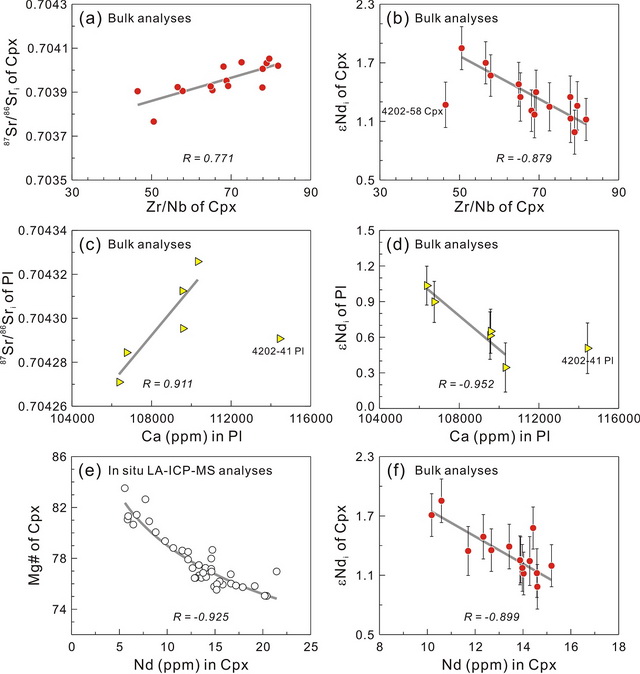
As one of the most important geodynamic systems, mantle plumes are not only responsible for the generation of large igneous provinces, but are also associated with many economically important mineral deposits. Most Layered mafic intrusions (LMI) formed via multiple magma injections into crustal magma chambers. The parental magmas of LMI have inevitably, to some extent, interacted with subcontinental lithospheric mantle (SCLM) and crust during ascent and emplacement. In this regard, crustal assimilation-fractional crystallization (AFC) processes may have played an important role in the magmatic evolution and petrogenesis of LMI.
Studies demonstrated that the Xiaohaizi wehrlite intrusion is composed mainly of olivine (Fo69-75), clinopyroxene (Mg#75-84), intercumulus plagioclase (An53-86) and Fe-Ti oxides. Both petrography and mineral compositions suggest that olivine and clinopyroxene crystallized earlier than plagioclase and Fe-Ti oxides. The dykes are of alkali basalt to trachyandesite with low Mg# (35-39). The least-contaminated dykes display strong rare earth element (REE) fractionation, enrichment of Nb and Ta, and depletion of Pb relative to other similarly incompatible elements, bearing strong similarity to ocean island basalts (OIB). This, together with their positive eNdi values (4.3-4.8), is consistent with derivation from an enriched asthenospheric mantle source.
Clinopyroxenes in the wehrlites display convex-upward chondrite-normalized REE patterns. The melts in equilibrium with these clinopyroxenes have very similar trace element compositions to those of the crosscutting dykes, suggesting a similar mantle source shared by the Xiaohaizi wehrlite intrusion and dykes. The Xiaohaizi wehrlite intrusion is characterized by Sr-Nd isotopic disequilibrium between clinopyroxene and plagioclase separates (Fig. 2): 87Sr/86Sri (0.7038-0.7041) and eNdi (1.0-1.9) of clinopyroxene are lower and higher than the respective ratios of intercumulus plagioclase (87Sr/86Sri = 0.7042-0.7043, eNdi = 0.4-1.0). The 87Sr/86Sri and eNdi of clinopyroxene separates correlate positively and negatively with Zr/Nb (Fig. 3a-b), respectively, implying variable degrees of crustal contamination during the formation of the Xiaohaizi wehrlite intrusion. 87Sr/86Sri increases and eNdi decreases with increasing Ca content of plagioclase (Fig. 3c-d), indicating that higher An plagioclases experienced higher degrees of contamination. This can be explained by assimilation of continental crust through a turbulent magma ascent (ATA) process. However, this ATA model fails to account for the positive correlation between the Mg# and eNdi of clinopyroxene separates (Fig. 3e-f). The isotopic disequilibrium in the Xiaohaizi LMI is more probably generated during an assimilation and fractional crystallization process involving Archean-Neoproterozoic basement and carbonates as contaminants.
This study has published in December 2014 in Journal of Petrology (Wei et al. 2014. Petrology and Sr-Nd Isotopic Disequilibrium of the Xiaohaizi Intrusion, NW China: Genesis of Layered Intrusions in theTarim Large Igneous Province. Journal of Petrology 55, 2567-2598).

Sr-Nd isotope compositions of clinopyroxene and plagioclase separates in the Xiaohaizi wehrlite intrusion. (Image by WEI Xun)

Variation of 87Sr/86Sri (a) and eNdi vs trace element (ratio) of clinopyroxene and plagioclase mineral separates in the Xiaohaizi wehrlite intrusion. (Image by WEI Xun)

86-10-68597521 (day)
86-10-68597289 (night)

52 Sanlihe Rd., Xicheng District,
Beijing, China (100864)

